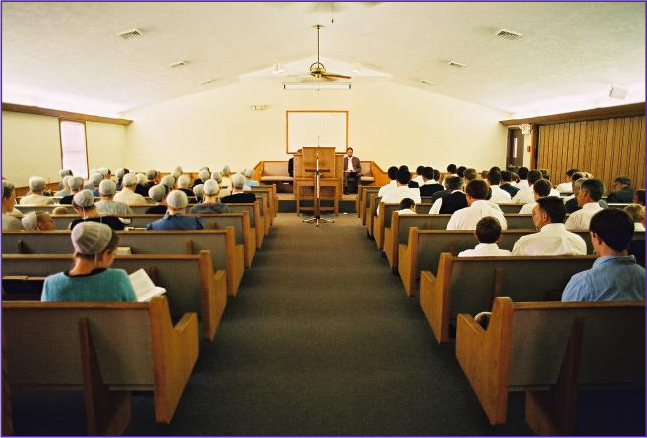


|
Beliefs, Practices, and Doctrine |


































|
The Beachy Amish-Mennonites are a Christian group with an Anabaptist heritage, evangelical emphasis, and community-based traditionalist practice. They are neither a mainstream church nor a cult, but are rather considered a sect, orthodox in Christian belief but somewhat separate from society. Some distinctive beliefs include: · Baptism upon confession of Jesus Christ by a person who has reached an age of accountability. Thereafter, the church community provides members with lifelong accountability and direction in order to uphold God’s directives for holiness as revealed through the Bible and by the Holy Spirit through the brotherhood . · Emphasis on the essential role of church community as a supporting organism for spiritual growth, fellowship, and accountability. · Nonresistance, that is, returning good for evil and not resisting a persecutor. This includes non-involvement in armed combat. · An extent of practical everyday separation from mainstream society, especially in areas of social and recreational activities, personal adornment, amusement, speech, gender roles, and schooling. · A covering for women in obedience to 1 Cor. 11:1-16. · Godly judgment is to take place within the church. The church is not responsible for judging the Christian devotion of those outside the immediate church and constituency, but rather to tend to the flock. · This is paralleled by an outreach program that aims to inform and encourage non-Christians and lax Christians of the fallen state of man and the opportunity to follow Jesus Christ as devout servants of God.
Confession of Faith As with the Old Order Amish, Beachy Amish-Mennonites espouse the Dortrecht Confession of Faith, written in 1632 by Dutch Mennonite church leaders. This confession provides an overview of what the Beachy Amish-Mennonites believe regarding core matters of belief and practice. The articles in this confession are titled as follows: I. Of God and the Creation of all ThingsII. Of the Fall of ManIII. Of the Restoration of Man Through the Promise of the Coming ChristIV. The Advent of Christ into This World, and the Reason of His ComingV. The Law of Christ, i.e., the Holy Gospel or the New TestamentVI. Of Repentance and Reformation of LifeVII. Of Holy BaptismVIII. Of the Church of ChristIX. Of the Election, and Offices of Teachers, Deacons, and Deaconesses, in the ChurchX. Of the Holy SupperXI. Of the Washing of the Saints' FeetXII. Of the State of MatrimonyXIII. Of the Office of the Secular AuthorityXIV. Of RevengeXV. Of the Swearing of OathsXVI. Of the Ecclesiastical Ban, or Separation from the ChurchXVII. Of Shunning the SeparatedXVIII. Of the Resurrection of the Dead, and the Last Judgment
Click here to read an online copy of the Dortrecht Confession of Faith.
Statements of Position Nearly all Beachy Amish-Mennonite churches have a statement of belief and practice observed by the local congregation. These statements address topics like doctrine, dress, recreation, technology, interior design, and devotion to church programs. The idea is to add flesh to the harder teachings of the New Testament for today’s age in a way that is meaningful and relevant.
Beachy Amish-Mennonites have agreed to uphold only a small consortium of beliefs and practices as a denomination. The following statements were written by Beachy Amish-Mennonite ministers and adopted at annual ministers' meetings. These documents are intended to serve as open statements of position and reinforcement for current beliefs and practices upheld by Beachy congregations. To participate fully in Beachy programs and ministries, Amish-Mennonite congregations must practice the minimums of these statements.
Radio and Television (download)
Peace, War, and Social Issues (download)
Pamphlets Two pamphlets authored by anonymous Beachy Amish-Mennonite leaders.
Where Is God? “There are more than two hundred religions in America. Some differ sharply from others in thought and purpose. Even among those that are similar there is much contradiction. You may be confused by the teaching of so many different churches. Or maybe you are committed to one of them without experiencing the assurance that you are indeed reconciled to God. As the apostle John writes in…” Read more: PDF format
The Beachy Amish Mennonites: Who They Are, What They Believe PDF format
Specific Issues of Concern The following document, A Charge to Keep, I Have, was drafted by five Beachy bishops and endorsed by many church leaders. It was an attempt to establish a common constitution around which Beachy churches could rally. While never adopted officially as the church’s sentiment (see “Beachy Amish Polity”), most points represent the specific concerns of churches today, especially conservative churches that have formed new Amish-Mennonite subgroups in recent years, such as Maranatha Amish-Mennonite. While some items may seem trivial to outsiders, leaders who support the concerns within this document believe that being faithful in all things includes being faithful in seemingly small things. Societal pressures in this age subtly undermine the church and moral devotion. The document was written in the early 1990s and reflects that period, though concerns continue in more recent forms (such as VHS is now DVD). It addresses the following issues: 1. Divorce and Remarriage 2. Excommunication and Shunning 3. Television 4. Radio 5. Video 6. Sister’s Veiling 7. Instrumental Music 8. Public Bathing 9. Casual Wear 10. Rock, Country, Secular Music 11. Courtship Standards 12. Sports 13. Lord’s Day Activities 14. Properly-Chaperoned Youth 15. Hairstyles 16. Mutual Respect for Committee Work 17. Effective Teaching Program for Parents 18. Scriptural Unity
A Charge to Keep, I Have PDF format
Overview of Core Beliefs Contributed
To conservative Anabaptists such as the Beachy Amish Mennonites, it is not enough for a church to claim to believe the right doctrine. Rather its basic structure needs to enforce the core values of non-conformity, humility, servanthood, and mutual aid based on the Bible.
The church structure itself reflects the value of humility. For example, the church meets in a simple building without expensive ornamentation. Music is sung a cappella without solos or any performances that would make a few people stand out. Churches are kept small enough to ensure that the ordained men know all the members well. Shared leadership prevents the church from focusing on a single personality and making that person proud.
The doctrine of non-conformity is based on "Be not conformed to this world" Romans 12: 2. The church does not to reflect the "pride of life" or ephemeral trends of society. Lasting values such as brotherhood, purity, devotion to God and service are stressed rather than marketing the gospel according to society's perceived needs. Members practice non-conformity in everyday life. Women wear a modest cape dress that is designed to hide the feminine figure. Men avoid costly or showy clothes. Television and worldly music are forbidden. Children are raised to work from an early age and educated at home or in a church-run school with the idea that education should train them to be of service to others, rather than for their personal advancement. Courtship is not viewed as just between two people, but includes guidance from both families and the brotherhood.
Church resources go towards the church school, mutual aid and missions, rather than to elaborate buildings, programs and sound equipment. The congregation selects a pastor based on the quality of his personal Christian life and dedication rather than his dynamic personality or formal education.
Humbling oneself is essential to membership. Privacy is not as important as accountability. However, this structure prevents the degrading bondage of cults because all the men meet together as a brotherhood to determine what the church practice is by consensus, preventing a strong personality from making rules to advance his personal agenda. The brotherhood works together to help the men lead their families by example and teaching, support them adequately, train their children and overcome personal problems. While women do not have spelled out "rights" as are necessary in secular society, the system ensures that men take good care of their families and receive support if they should fall into sin or have emotional problems. Domestic violence is associated with isolation, and the brotherhood does all it can to help families thrive.
Preparation for communion also enforces the value of humility. Members meet to share, make confession, and obtain help in making peace if there is a dispute between members. All must be at peace and in agreement before communion. Members wash one another's feet to demonstrate humility and service.
The humble lifestyle allows members to pursue a life of servanthood. Clothing, food, shelter, and cars are simple, void of "vain display." People strive for economy by canning their own food, buying used items when appropriate, and making needed items when possible. Work becomes a chance for fellowship as people get together to help others move or do other tasks. The value of an occupation is based on whether it helps others and how it affects family life rather than by status or income. Working with one's hands is considered honorable and a contributor to strong character. Servanthood shows itself in the wide participation in missions and service. Members view every contact with outsiders as a chance to witness and try to minister to whatever personal needs they encounter in friendships with outsiders. Young ladies frequently work for families helping to care for the household when a mother has young children. They may work teach in schools or work in one of the Beachy's volunteer facilities for the developmentally delayed or aged. Young men join work crews, which use their skills at time for service such as building churches or helping rebuild homes of disaster victims. Whole families will relocate to areas without a conservative Anabaptist church to start a church, whether it be in the United States or another country. Church members visit convalescent homes, elderly facilities, prisons, orphanages and neighbors in need. The simple lifestyle allows the church to have an impact unbelievable for its small size.
Mutual aid is another core value. The church encourages members to maximize interdependence. When a new family wants to become part of the church, members try to find them a place to live, such as in a guest house on their property or in a rental someone in the church owns. If possible, they try to employ them in a business run by church members. Some churches even avoid insurance and social security altogether. Offerings cover huge medical bills and life's disasters. Members consider it their responsibility to help any seeker who comes their way and offer whatever generous help in material or spiritual aid they can offer.
The church service also reflects the value of mutual aid. The men all take turns sharing a devotional or topical study during the church service, helping each man to improve his Bible study and public speaking skills, as well as giving him some responsibility for the spiritual growth of the congregation. If there is a guest from a similar church, he is invited to share a devotional exposition at the beginning of the service. Sunday School is held prior to the sermon. Finally, one of the ordained men or a visiting ordained man gives the message so that the church hears a variety of voices. Unlike many churches where few men go, men learn that their participation is essential. Brotherhood meetings of all the men decide practical and spiritual issues.
Women's roles are important, but behind the scenes. Families are large, and some may choose to adopt. It's not unusual to see families with 5 or more children. Women teach the children self-discipline and other basic spiritual values. Women also practice hospitality, having both church families and outsiders over for meals frequently. The women's cooking, canning, gardening and sewing are a significant financial contribution to the family. If there are no children or the children are grown, many women work in the family business. Single women often serve in orphanages and by teaching school. The congregation takes on the responsibility of supporting them, providing housing, paying medical costs etc., providing more security than most Christian ministries provide. |
















